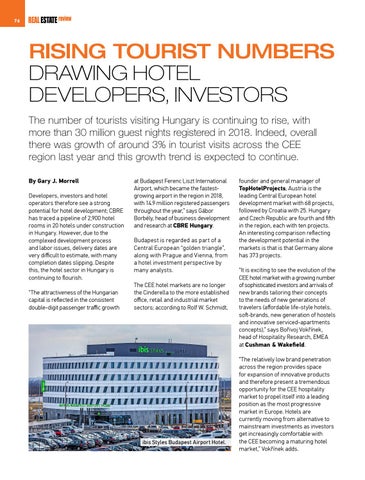76
REAL ESTATE review
RISING TOURIST NUMBERS DRAWING HOTEL DEVELOPERS, INVESTORS The number of tourists visiting Hungary is continuing to rise, with more than 30 million guest nights registered in 2018. Indeed, overall there was growth of around 3% in tourist visits across the CEE region last year and this growth trend is expected to continue. By Gary J. Morrell Developers, investors and hotel operators therefore see a strong potential for hotel development; CBRE has traced a pipeline of 2,900 hotel rooms in 20 hotels under construction in Hungary. However, due to the complexed development process and labor issues, delivery dates are very difficult to estimate, with many completion dates slipping. Despite this, the hotel sector in Hungary is continuing to flourish. “The attractiveness of the Hungarian capital is reflected in the consistent double-digit passenger traffic growth
at Budapest Ferenc Liszt International Airport, which became the fastestgrowing airport in the region in 2018, with 14.9 million registered passengers throughout the year,” says Gábor Borbély, head of business development and research at CBRE Hungary. Budapest is regarded as part of a Central European “golden triangle”, along with Prague and Vienna, from a hotel investment perspective by many analysts. The CEE hotel markets are no longer the Cinderella to the more established office, retail and industrial market sectors; according to Rolf W. Schmidt,
ibis Styles Budapest Airport Hotel.
founder and general manager of TopHotelProjects, Austria is the leading Central European hotel development market with 68 projects, followed by Croatia with 25. Hungary and Czech Republic are fourth and fifth in the region, each with ten projects. An interesting comparison reflecting the development potential in the markets is that is that Germany alone has 373 projects. “It is exciting to see the evolution of the CEE hotel market with a growing number of sophisticated investors and arrivals of new brands tailoring their concepts to the needs of new generations of travelers (affordable life-style hotels, soft-brands, new generation of hostels and innovative serviced-apartments concepts),” says Bořivoj Vokřínek, head of Hospitality Research, EMEA at Cushman & Wakefield. “The relatively low brand penetration across the region provides space for expansion of innovative products and therefore present a tremendous opportunity for the CEE hospitality market to propel itself into a leading position as the most progressive market in Europe. Hotels are currently moving from alternative to mainstream investments as investors get increasingly comfortable with the CEE becoming a maturing hotel market,” Vokřínek adds.




















